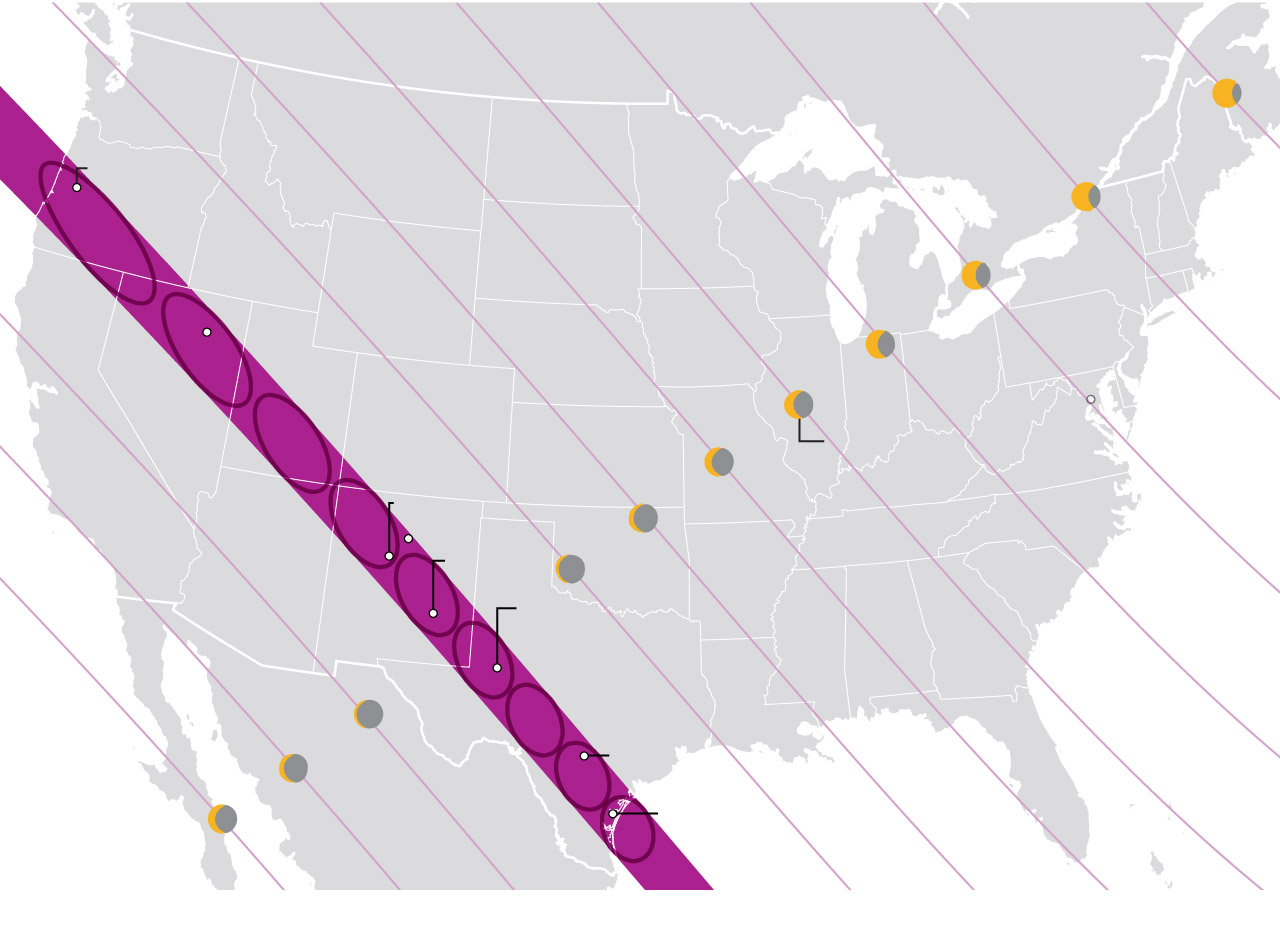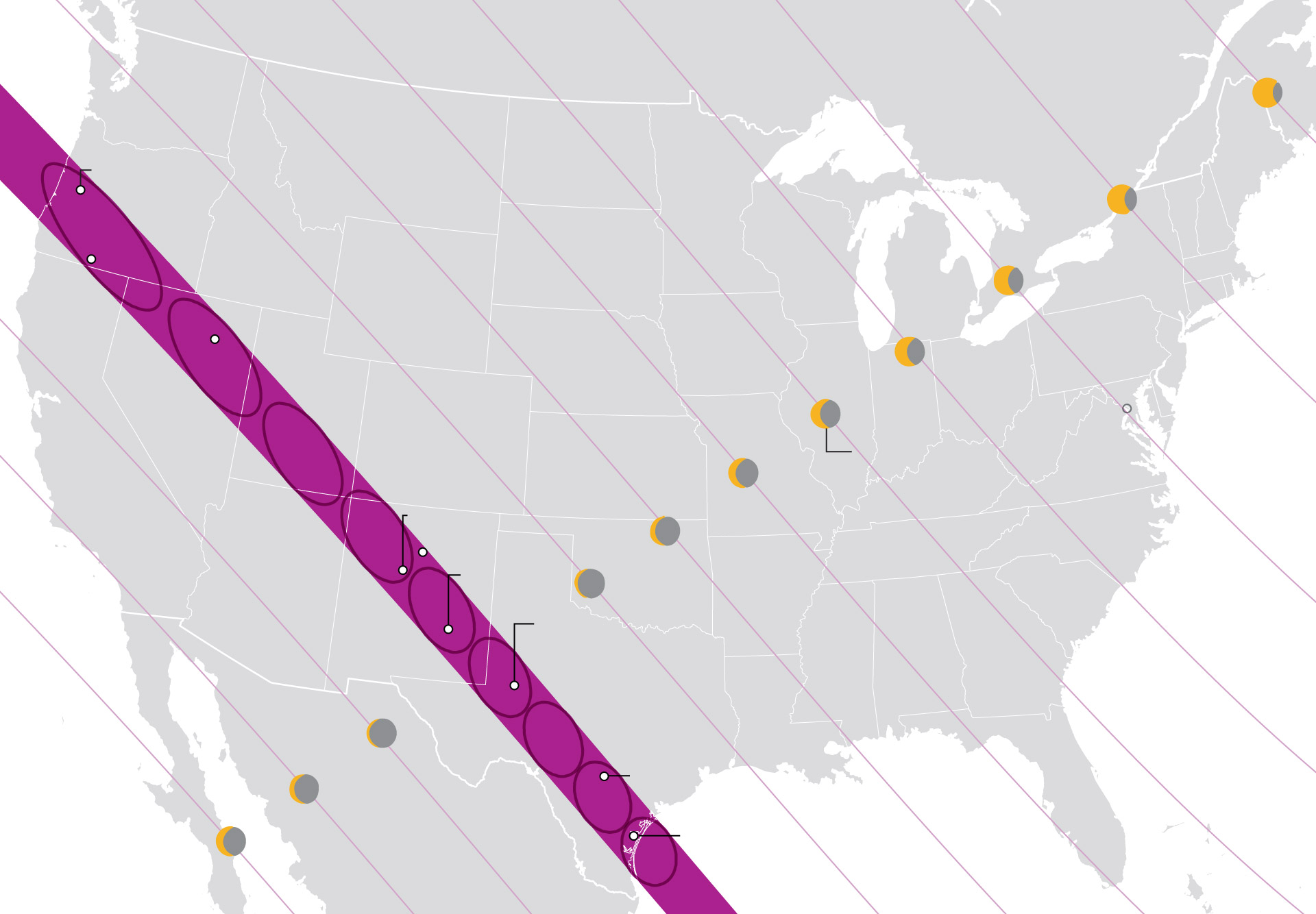Saturday will feature a “ring of fire” solar eclipse from Oregon to Padre Island, Tex., sweeping across portions of nine states before cruising over the Yucatán Peninsula, Central America, Colombia and Brazil. Tens of millions will turn to the sky sporting special eclipse glasses, eager to catch a glimpse of a rare planetary alignment that will leave the moon interceding between the earth and the sun.
While still an impressive sight, this weekend’s annular eclipse is distinctly different from a total solar eclipse: During a total eclipse, the moon fully blocks the sun, but this time around, the moon is too far away to cover the solar disk. The result? An annular solar eclipse, with a narrow ring of sunlight left behind the dark silhouette of the moon.
The ring of fire effect, known as full annularity, will last nearly five minutes in the center of the eclipse’s path. For those outside the path of annularity, a partial solar eclipse will be visible. That’s the case across the entire Lower 48, where the sun will take the shape of a crescent or a sickle when eclipsed.

2023 Annular Solar Eclipse
Oct. 14
Detail below
Eclipse path
NORTH
Eugene
ORE.
Klamath
Falls
9:20 am PDT
Elko
9:25 am PDT
NEV.
UTAH
10:30 am MDT
ARIZ.
COLO.
10:35 am MDT
Albuquerque
N.M.
10:40 am MDT
Roswell
11:45 am CDT
Midland
TEX.
11:50 am CDT
MEXICO
San Antonio
11:55 am CDT
Corpus Christi
12:00 pm CDT
Source: NASA
LAUREN TIERNEY/THE WASHINGTON POST

2023 Annular Solar Eclipse
Oct. 14
Detail below
Eclipse path
NORTH
Eugene
ORE.
Klamath
Falls
9:20 am PDT
Elko
9:25 am PDT
NEV.
UTAH
10:30 am MDT
ARIZ.
COLO.
10:35 am MDT
Albuquerque
N.M.
10:40 am MDT
Roswell
11:45 am CDT
Midland
TEX.
11:50 am CDT
MEXICO
San Antonio
11:55 am CDT
Corpus Christi
12:00 pm CDT
Source: NASA
LAUREN TIERNEY/THE WASHINGTON POST

CANADA
10%
Eugene
20%
ORE.
2023 Annular Solar Eclipse
30%
Oct. 14
9:20 am
PDT
40%
NEV.
Elko
UTAH
Washington, D.C.
50%
9:25 am PDT
COLO.
Amount of sunshine
diminished
60%
10:30 am MDT
ARIZ.
Albuquerque
70%
Santa Fe
10:35 am MDT
Roswell
80%
N.M.
Midland
10:40 am MDT
TEX.
11:45 am CDT
MEXICO
80%
11:50 am CDT
San Antonio
70%
11:55 am CDT
Corpus Christi
60%
12:00 pm CDT
Source: NASA
LAUREN TIERNEY/THE WASHINGTON POST

CANADA
10%
Eugene
20%
ORE.
2023 Annular Solar Eclipse
Oct. 14
Klamath
Falls
30%
9:20 am PDT
40%
Elko
NEV.
UTAH
Washington, D.C.
9:25 am PDT
50%
Amount of sunshine
diminished
COLO.
60%
10:30 am MDT
ARIZ.
Albuquerque
70%
Santa Fe
10:35 am MDT
Roswell
80%
N.M.
Midland
10:40 am MDT
TEX.
11:45 am CDT
MEXICO
80%
11:50 am CDT
San Antonio
70%
11:55 am CDT
Corpus Christi
60%
12:00 pm CDT
Here are five things to look for during Saturday’s solar eclipse:
1. The puffy clouds will flatten
Cumulus clouds, or “fair-weather” clouds, require upward motion from daytime heating to form. During a deep solar eclipse, the moon blocks a substantial portion of the sun, cutting back on how much sunlight reaches the earth. During peak annularity, some folks may be receiving only a tenth of the sunlight, and therefore heating, they typically experience, meaning there will be less warmth to generate updrafts and, in turn, cumulus clouds. There won’t be many anyway, since it will be early in the day, but pay attention to the dissipation of any puffy cloud cover as the deepest part of the eclipse nears. This effect will still be prevalent even outside the path of annularity.
On Aug. 21, 2017, a total solar eclipse briefly extinguished daylight in Nebraska. That cut back on how much instability, or storm fuel, could be mustered. While weather models simulated the development of severe afternoon thunderstorms, virtually no downpours formed because of the reduction in daytime heating.
2. Look for sunspots
Provided you are wearing special ISO-certified solar eclipse glasses, you’ll be able to stare directly at the sun. If you look closely on the orange-colored disk, you may also notice a couple of “sunspots,” or bruiselike discolorations on the surface of the sun that throb and pulsate with energy.
Sunspots are cooler, dark regions that form as a result of interfering magnetic bands that wrap horizontally across the sun; like bubbles in a lava lamp, these blobs of enhanced magnetic field float to the sun’s surface, where they crackle with “solar flares” and “coronal mass ejections.” If a so-called CME is launched toward Earth, which is most likely when a sunspot is directly facing Earth, it can cause geomagnetic storming and instances of the northern lights.
There are sunspots presently on the eastern limb of the sun, as well as just south of the sun’s equator near the center of the solar disk.
3. Bailey’s beads will be visible
For those in the path of annularity, there will be a moment called “second contact,” when the back edge of the moon is still blocking, but almost immersed within, the solar disk. For about 30 seconds, pinpricks of sunlight will shine through the peaks and valleys of the moon. These are known as “Bailey’s beads,” and they’re a favorite of astronomers and astrophotographers.
4. Look in the shade of trees
If you look closely at the shadows of trees, you’ll see hundreds of little sickles or rings of sunlight. That’s because the leaves act as miniature “pinhole projectors,” which means small versions of the sun are cast onto the ground below. Consider bringing a white piece of paper or poster board so you can better spot the shadows.
5. Appreciate the eerie dimness
If you’re in the path of annularity, you’ll reach a point where less than 10 percent of the sun will effectively be shining. Interestingly, the sky won’t turn dark or noticeably change color, but instead the entire landscape will seem dim. You might notice you have a tougher time making out the details on your friend’s face, for example, or that the streetlights begin to illuminate. It’s a very unsettling feeling.
In ancient times, the dimming of the sun during an eclipse often evoked emotions of dread and doom and, until one experiences an annular or total solar eclipse, it’s impossible to experience why. Also pay attention to other environmental cues — the quieting of birds or the chirping of crickets. Chickens will return to their roosts as if night is about to fall. In a sense, it is.


